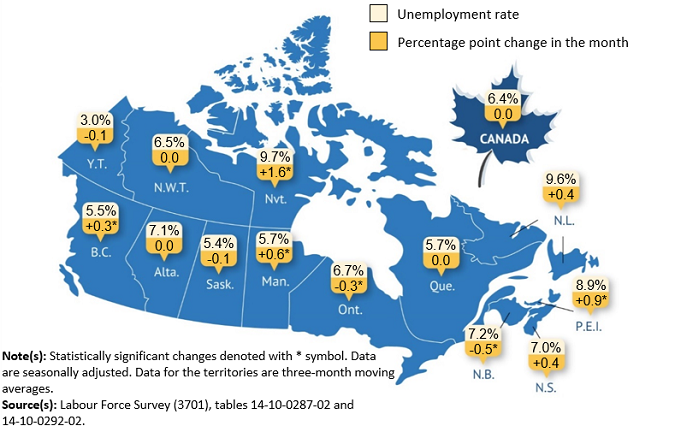Employment in Canada saw little movement in July 2024, with the overall number of employed individuals virtually unchanged, according to the latest Labour Force Survey. The total employment figure edged down by 2,800, representing a negligible decline of 0.0%, while the national unemployment rate remained steady at 6.4%.
Despite the overall stability, certain demographic groups and sectors experienced notable shifts. Employment decreased among Canadians aged 55 to 64, with women in this age group seeing a significant drop of 41,000 jobs, a 2.6% decrease, and men experiencing a smaller decline of 15,000 jobs, or 0.8%. Young men aged 15 to 24 also faced job losses, with employment in this demographic falling by 20,000, a 1.5% decrease.
Conversely, men in their core working years (25 to 54 years old) saw employment rise by 48,000 jobs, an increase of 0.7%. This uptick helped to partially offset employment declines seen in this group in previous months.
Sectoral shifts and regional variations
The wholesale and retail trade sector experienced the most significant job losses in July, shedding 44,000 positions, a 1.5% decline. This sector has been on a downward trend since August 2023. The finance, insurance, real estate, rental, and leasing sectors also saw declines, with employment falling by 15,000 jobs, marking the first decrease since November 2023.
On the other hand, public administration employment increased by 20,000 jobs, or 1.6%, while the transportation and warehousing sectors added 15,000 jobs, a 1.4% increase. The utilities sector also saw gains, with employment rising by 6,200 jobs, or 4.2%.
Regionally, Ontario saw the largest employment gain, adding 22,000 jobs, a 0.3% increase, driven by growth in full-time positions. Saskatchewan also experienced an increase of 6,700 jobs, a 1.1% rise. However, Manitoba and Nova Scotia faced declines, with employment falling by 5,400 jobs (0.8%) and 4,800 jobs (0.9%), respectively.

Wage growth and labour market participation
Average hourly wages for employees increased by 5.2% year-over-year, reaching $34.97, continuing the trend of wage growth observed in June. Total hours worked across the country rose by 1.0% in July and were up 1.9% compared to the same period last year.
The labour force participation rate, however, declined by 0.3 percentage points to 65.0%, marking the lowest rate since June 1998, excluding the pandemic years of 2020 and 2021. This decline was particularly pronounced among younger and core-aged women, as well as young men.
Challenges for returning students and recent immigrants
The labour market remained challenging for returning students aged 15 to 24, with their employment rate dropping to 51.3%, the lowest since 1997, outside of the pandemic period. The unemployment rate for this group reached 17.2%, the highest for July since 2009.
Recent immigrants also faced increased unemployment, with their rate rising by 3.1 percentage points to 12.6% over the past year. Young recent immigrants were particularly hard hit, with an unemployment rate of 22.8%, up 8.6 percentage points from the previous year.
As Canada continues to navigate economic uncertainties, these figures highlight the ongoing challenges and shifts within the labour market, with specific demographic groups and industries facing varying levels of impact.





